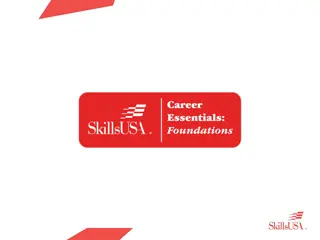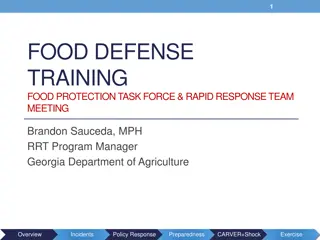Essential Self Defense Tips and Techniques for Personal Safety
Explore the world of self-defense with insights from BJJ Black Belt Alex Vamos. Learn about physical and mental self-defense, enhancing awareness, important skills to master, assessing safety in hangout spots, and trusting your instincts to stay safe from potential threats.
Download Presentation

Please find below an Image/Link to download the presentation.
The content on the website is provided AS IS for your information and personal use only. It may not be sold, licensed, or shared on other websites without obtaining consent from the author. Download presentation by click this link. If you encounter any issues during the download, it is possible that the publisher has removed the file from their server.
E N D
Presentation Transcript
Introduction to Self Defense By BJJ Black Belt Alex Vamos
Types of Self Defense Physical self defense Mental self defense
Physical Self Defense Physical Self-defense is the use of physical force to counter an immediate threat of violence. Such force can be either armed or unarmed. In either case, the chances of success depend on a large number of parameters, related to the severity of the threat on one hand, but also on the mental and physical preparedness of the defender
Mental Self Defense Mental self defense is the ability to get into the proper mindset for executing a physical self defense technique. Many martial arts schools and self defense classes focus primarily on the physical nature of self defense but it s very important to focus on the mental aspect as well
Awareness Lessen Your Chances of Being a Victim Be aware of your surrounding and situations that might be dangerous Know how to avoid these situations Know what choices to make if you find yourself in a potential situation (walking on cellphone)
Four key self defense skills that you should be aware of are Using your head De-Escalating a bad situation Reduce your risk Taking self defense classes
Check out hangouts. Do they look safe? Are you comfortable being there? Ask yourself if the people around you seem to share your views on fun activities If you think they re being reckless, move on. Be sure your body language shows a sense of confidence. Look like you know where you re going and act alert
Trust your instincts One way to avoid a potential attack before it happens is to trust your instincts. Instincts combined with common sense can get you out of trouble. Ex- If you are running alone on a school track and you suddenly feel like you are being watched, that could be your intuition telling you something. Your common sense would then tell you to go where there are more people around
1. Always, trust you instincts. If you feel uneasy in a situation do something about it, don t worry about appearing foolish or overly cautious. 2. Believe in yourself. Have the strength to be independent. Don t allow your self to be intimidated.
De- Escalating A Bad Situation De-escalating a situation means speaking or acting in a way that can prevent things from getting worse. Attackers aren t always strangers who jump out of dark alleys. Sadly, we can be attacked by people we know. That s where the skill of de- escalating a situation comes in
Why De-escalation works Something as simple as not losing your temper can de-escalate a situation. Learn how to manage your own anger effectively so that you can talk or walk away without using your fists or weapons.
Although de-escalation wont always work, it can only help matters if you remain calm and don t give an attacker any extra ammunition. Whether it s a stranger or someone you thought you could trust, saying and doing things that don t threaten your attacker can give you some control
Reducing your risk When you go out - Make sure your are comfortable with the plans - Stay in group situations - Make sure you have your cellphone and your battery is charged - Let other people know your plans
When at Home - Keep entrances well lit - If someone comes to the door, never give the impression you are alone - Have doors locked In your car -Always have your keys out to be ready to get into your car - Lock doors right after entering - Park in well lit areas - Always lock your car
You can reduce your risks of being a victim by doing things that can help you stay safe Make sure your friends and parents know your daily schedule (classes, sports practice, club meetings, etc.) If you go on a date or with friends for an after game snack, let someone know where you re going and when you expect to return
Reasons Why Everyone Should Take Self Defense Training Self defense training will build confidence. Many people are unconfident with their abilities to protect themselves before they learn self defense It helps develop self discipline Which will help you be motivated and dedicated It will make you more aware of your surroundings
You have the right to use reasonable force to prevent a crime including defending yourself. What is reasonable force? In a situation where you feel uncomfortable it is important to access the level of threat (no threat, low threat medium threat, high threat) and the appropriate response ot that threat. The level of force you respond with must be appropriate to the situation
Martial Art Self Defense Techniques Striking When it comes to Self Defense strikes and blows are some of the most common attacks. Generally speaking, striking refers to your kicks, punches, head butts, knees, elbows and other attacks.
Blocks Your opponent is most likely going to strike back. One of the martial arts techniques that you can use to minimize the an attack is a block. Blocking is the act of stopping your opponents strike before it is completed. The arms are most commonly used for blocking, but your legs can also be used at times.
Takedowns Takedowns occur when you actually bring your opponent to the ground. There are many different ways to accomplish a takedown.
Throws Throws are another form of takedowns. During a throw, you maneuver your body and legs to take down your opponent . The end result is that your opponent is brought to the ground.
Submissions The goal is to force your opponent to give up or submit.
Important Tips When defending yourself always keep your hands up, and elbows down. This will give you the best defense for your body and head.
Take a Self Defense Class The best way to prepare yourself to fight off an attacker is to take a self defense class. The more you practice techniques, the more confident you will feel applying its against a resisting opponent.

























